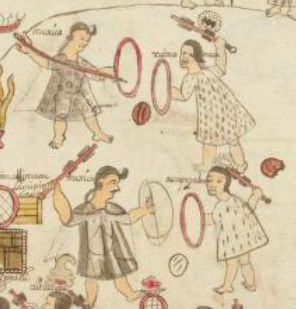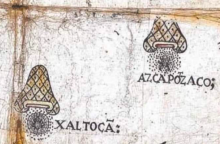Xaltocan (Azca16)
This black-line drawing of the compound place name Xaltocan (perhaps “Place of Sand Spiders”) shows a bird’s eye view of many dots in a circular shape. This represents sand (xalli). In the middle of this sand is a black spider (tocatl) with a segmented body and seven legs (probably intending eight). The locative suffix (-can, where) is not shown visually, but perhaps implied by the landscape.
Stephanie Wood
Elizabeth Hill Boone translates Xaltocan as "Sand Spider," which may be the best analysis for now. This place was allegedly given to a Chichimec immigrant named Chicomecuauh, who was treated well by Xolotl. [See her Stories in Red and Black (2000), 185.] The gloss on this manuscript actually reads, in full, xaltocameca, referring to an ethnic group. The reference is to the person fighting. The singular would be Xaltocamecatl. [Rafael Sandoval discusses the suffix on this ethnic term in his Arte de la Lengua Mexicana (1810), p. 50.] Please note that the lower edge of the sand in the glyph was obscured and reconstructed here for the purpose of making more useful comparisons with other bodies of sand. The contextualizing image shows the form of dress of the Xaltocameca, and the shield and weapon being used in combat. The Xaltocameca appear in the larger scene taking Mexicas captive, including the famous (elder) Huitzilihuitl and his two daughters, Chimalxoch and Tozpanxoch.
Stephanie Wood
xaltoca
Xaltocan
Stephanie Wood
post-1550, possibly from the early seventeenth century.
Jeff Haskett-Wood
arena, arañas, pueblos, topónimos, nombres de lugares
This image of another Xaltocan glyph comes from the Tira de Tetepilco, the image was posted to Facebook by Tinta y Pintura 24 March 2024. The intention there was to highlight the differences between the Xaltocan and Azcapotzalco glyphs, which do have some similarities. (SW)

xal(li), sand, https://nahuatl.wired-humanities.org/content/xalli
toca(tl), a spider, https://nahuatl.wired-humanities.org/content/tocatl
-can (locative suffix), where, https://nahuatl.wired-humanities.org/content/can-2
posiblemente, Lugar de Arena-Arañas
Stephanie Wood
The Codex Azcatitlan is also known as the Histoire mexicaine, [Manuscrit] Mexicain 59–64. It is housed in the Bibliothèque Nationale de France, and hosted on line by the World Digital Library and the Library of Congress, which is “unaware of any copyright or other restrictions in the World Digital Library Collection.”
https://www.loc.gov/resource/gdcwdl.wdl_15280/?sp=16&st=image
The Library of Congress is “unaware of any copyright or other restrictions in the World Digital Library Collection.” But please cite Bibliothèque Nationale de France and this Visual Lexicon of Aztec Hieroglyphs.






